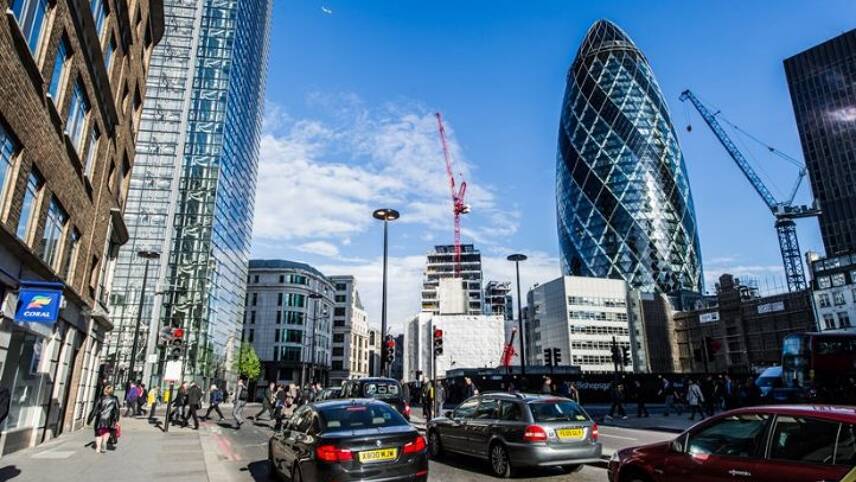Register for free and continue reading
Join our growing army of changemakers and get unlimited access to our premium content

Skanska UK's most famous projects include the Gherkin (pictured)
The pledge covers the company’s existing portfolio of projects, including the Gherkin and the Ministry of Defence’s head offices, its planned and partially completed projects, such as Crossrail, and its entire supply chain.
In a bid to meet the new ambition, Skanska UK will purchase more renewable electricity to be used during its own construction programmes and building operations, while encouraging landlords of facilities it builds but does not manage to do the same.
It will also invest more heavily in technologies which minimise the energy use of its buildings, including on-site renewable arrays and low-carbon heating and cooling systems.
As for its supply chain, Skanska UK will work with suppliers to encourage a shift to low-carbon operations and products. It is already ranked as “A-“ by the CDP on its approach to sustainable timber and forest management. It will also publish estimates detailing the total supply chain emissions of all projects it undertook between 2010 and 2018 before the end of the year, and release this data on an annual basis going forward.
As an interim target on the road to 2045, Skanska UK is aiming to halve its total carbon footprint by 2030, against a 2010 baseline. This will require the company to cut its carbon intensity – the amount of CO2e it produces per £1m of revenue – to 130 by 2030, against a 2010 baseline of 351.
Skanska UK’s chief executive and president Gregor Craig said that the company had chosen to include supply chain emissions and to avoid buying carbon credits in order to “set the right strategy to deal with all emissions”.
“The construction industry is different to other sectors – you’ve got to look at emissions produced by sub-contractors and suppliers during construction and maintenance,” he said.
“If you only look at your own direct emissions, you don’t get a true picture.”
On carbon offsetting, he added: “[Carbon offsets] can divert attention and resources away from actually reducing the emissions produced by construction and maintenance activities. They would also add an extra layer of cost to the industry.
“We believe that cutting carbon could – and should – cut costs for the sector. Innovation will have a positive effect on the construction industry, helping to reduce emissions.”
Net-zero heroes
Skanska UK is one of many companies to have set a net-zero or carbon neutral commitment in recent months, in light of the Intergovernmental Panel On Climate Change’s (IPCC’s) recommendation that global carbon emissions should come down to zero by 2050, in order to limit the global temperature increase below 1.5C.
Technology giant BT, for example, committed last year to become a net-zero-carbon business by 2045, building on its existing science-based target to reduce emissions by 87% by 2030 against a 2016/17 baseline.
Elsewhere, the world’s largest container shipper, Maersk, is targeting carbon neutrality by 2050. The move will see Maersk work with governments and industry in order to help spur the development of net-zero vessels and shipping fuels in a bid to make these technologies commercially viable by 2030.
Other so-called “zeronauts” – businesses to have committed to a net-zero or net-negative carbon pathway – include the likes of modular flooring firm Interface, supermarket chain Aldi UK and Ireland, engineering and electronics giant Bosch and football club Forest Green Rovers.
The move from Skanska UK comes as the UK Government is deciding whether to adopt the Committee on Climate Change’s (CCC) advice for creating a net-zero carbon economy by mid-century. Several big-name players across the nation’s built environment sector have publicly voiced their support for the adoption of such legislation, with industry body the UK Green Building Council (UKGBC) having recently launched a framework advising designers, construction firms, landlords owners and occupiers on how to design, define and deliver net-zero for the industry.
Sarah George


The purchase of renewable electricity, and for some organisations, the declaration that they will purchase "100%" renewable electricity, is a puzzling one.
If the power purchased is at a time when the total demand for renewable electricity is high, but the generation is low, the claim is simply invalid.
Is the information available, at all times, of the total renewable generation, able to be compared with the total consumption by those having an agreement to purchase "100%" renewable power.
It is not valid to equate the total wattage supplied over a year with that paid for by the consumer. A deficit of renewable power at any time has to supplied by either fossil or nuclear power.
If nuclear power is removed from the equation as not being "renewable", the situation is even more questionable.
It is my suspicion that a great deal more power is purchased and paid for as "renewable", which is nothing of the sort.
Are instantaneous figures available which can prove or disprove this matter?
Richard Phillips